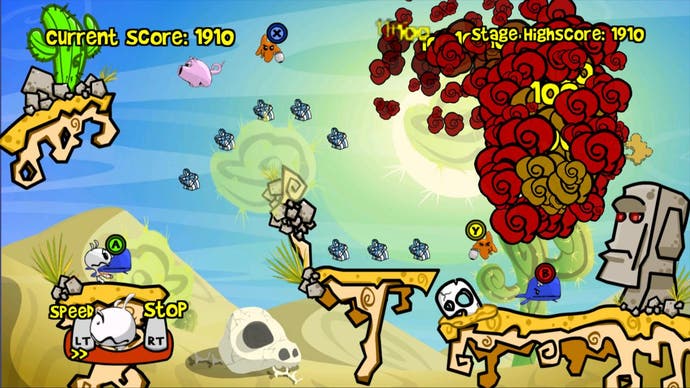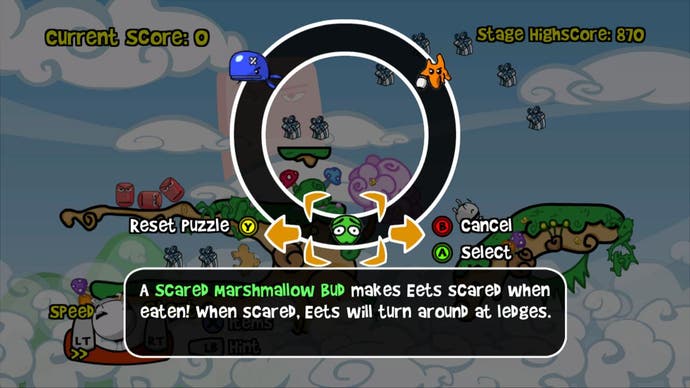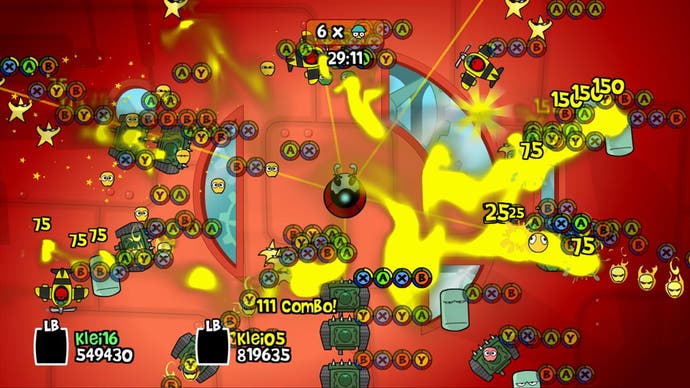Eets: Chowdown
Bit chewy.
According to Xbox Live's King of Ping, Major Nelson, Eets: Chowdown struggled in its first week on Arcade, failing even to topple crud like Teenage Mutant Ninja Turtles. Presumably that's because it has a rubbish name (I doubt Halo would have sold five million copies if it was called Skyhole: Floodpoker). It certainly isn't because it's a bad game.
A bit like a cross between Lemmings and legendary downloadable PC game Bridge Builder, this is a puzzle game where you help a little cartoon character called Eets through a 2D platform sequence by placing springboards, explosives and other objects, activating them when he wanders past, and often taking advantage of the game's carefully considered physics to propel him through the goal - all without ever taking direct control of Eets himself.
The goal in this case is a beaming jigsaw piece, which sits at one end of the static 2D platform level you're presented with while Eets (for it is he) is suspended, unmoving on the opposite side of the screen. Your job in this "build" phase is to reach into the toolbox and then use a PC-mouse-style pointer to position objects around the level. Some tools and items, like explosive minecarts, are then associated with a button so that you can activate them later. Other, unfixed items, like sweets, simply hang in the air, waiting for the physics to kick in.
And kick in they do, as soon as you pull the right trigger and start the level. At this point, sweets fall to the ground (and may roll downhill), Eets springs to life and starts walking along, and you're no longer allowed to place objects. Instead you can activate those you have placed, by pressing buttons the game mapped earlier. Depending on what you've set up, you can force Eets to turn around, change the distance he jumps, or even bounce him off to new heights, and hopefully send him flying into that all-important jigsaw piece.

At its most basic, you can deploy a prankster whale (yes, whale), which gobbles up Eets and spits him out in a uniform upward arc. Soon the game introduces the concept of moods - under normal (happy) circumstances, Eets will walk to the end of a platform and do a little hop off the end, but when he's scared Eets will walk backwards and forwards on a platform without jumping off until you intervene. If he's angry, he'll do a big somersaulting jump. Understandable.
These quirks of his character need to be worked into your solution, as it's all very well using a prankster whale to propel Eets from a low platform to a high one, but if he's scared then he won't be able to go anywhere from there, even if the jigsaw piece is tantalisingly close.
Fortunately you can cheer him up (or piss him off, depending on your requirements) by placing mood-changing sweets in his path. There are other ways to affect his status, too - using a brown cloud with a chocolate-chip-firing hat to shoot him a few times makes him angry, but if you simply fire a few chips at his feet and he eats them then he becomes happy again.
The further you get, the more it becomes apparent how versatile your tools can be - most propulsion devices, for example, can be used to propel items as well as Eets, so the same prankster whale or a springboard that allows you to fire an explosive minecart over an obstruction to blow a hole in the level, Worms-style, then allows you to send Eets over in the same direction. In order to keep things (relatively) simple, weights, and therefore trajectories, seem to be consistent across the board.

But while the physics are simple, they do play an increasingly important role, and - along with the versatility of the tools - inevitably lead to puzzles with multiple solutions. The obvious one might be to bounce Eets around the screen from whale to whale, before sending him to the jigsaw piece with a little help from a happy sweet, but with a bit of lateral thinking you might realise you can simply fire him at an explosive pill and use the force of its detonation to bounce him straight there.
As you move through each chunk of levels, the game continues to limit the amount of tools you can use, but also introduces new ones, giving you more and different choices within the restrictions that underwrite the challenge. The fourth zone, for example, forces you to deploy lights, because Eets quickly gets scared as he moves away from illuminated areas into the dark (and even falls off the edge of platforms), but in-keeping with the other things that affect Eets' mood, darkness is sometimes a pain, but just as often quite useful.
As puzzles becomes increasingly complex, you'll come to appreciate the hints (LB button) that suggest places to position your first object, although the decision to offer players an actual solution to the puzzle as well, simply by visiting the pause menu, has the potential to confuse. On the one hand, it allows you to cheat your way through all 123 puzzles. On the other, it's handy, both for struggling players and those who want to see how their solution compares to the "official" one.

Moreover, Eets is of most value to players who enjoy experimenting. In much the same way that it's fun to replay the same level of TrackMania or Mercury Meltdown over and over to find a better solution, finding a way to complete a level in Eets without using up all of your available tools is satisfying - and the game credits players who use their imagination, too, with a range of achievements reserved for players who can get through without exhausting their inventory.
In addition to all that, developer Klei has introduced a spin-off shoot-'em-up mini-game for Xbox Live Arcade that's bundled here. Called Marsho Madness, it puts you in the shoes (mallow?) of a sugary little sweet forced to fight off mounting waves of enemies by button-matching. Each enemy approaching the centre of the screen has buttons listed next to it (A X A, for instance) and by hitting those buttons in sequence you fire off a shot and hopefully destroy your adversary. Things heat up after a few minutes, and getting high scores is likely to keep devoted players busy, although in truth you'd be better off tracking down SEGA's Typing of the Dead if you want to play a Real Man's button-matching shoot-'em-up.
Fortunately you can always go back to the main Eets game, which - with its massive range of levels - ought to keep you occupied for several hours. You can also save your replays of your actions, and with the thrill of playing split around half and half between the satisfaction of getting there and the entertainment you get from watching slick solutions unfold like Hanna-Barbera Rube Goldberg machines, that's a handy inclusion, although it's a bit disappointing that you can't share your replays with others.
That said, if sharing replays - and indeed making and sharing levels - is a big deal for you, you can always go with the similarly priced PC version, which has been out for a while through digital distribution systems (like Steam), and embraces the free exchange of ideas and bouncy mazes. There's a "Download Content" button on the Xbox version's main menu, but we're not holding our breath for free stuff.

Besides the lack of replay-sharing though, the thing that's likely to prove really off-putting is the game's occasional descent into fiddly-ness. While in most cases it's fun to experiment, there are times when you've worked out the solution but implementing it is frustrating, with Eets snagging himself as he sails through the air, or items bouncing off ledges half the time and staying put for the other half. When you're trying to test whether you've got a trajectory right in the latter stages of a proposed solution, bouncing repeatedly off a tricky section early on can be extremely annoying, and as the puzzles increase in complexity so these little frustrations increase in number. Simpler graphics would have been nice in places too. We like colourful games, but we also like being able to easily distinguish foreground from background.
All of which leaves us with a game that's probably not as compelling as it might be, but that certainly has its moments. There are better physics puzzle games that are all about preparation (Armadillo Run, for example), and there are better physics puzzle games that give you full control (like Mercury), but this is a reasonable hybrid, and I can think of worse things to do than spending an evening or two in its company. Thanks to Major Nelson's top ten, I can also list them. Turtles, Turtles, Turtles, Turtles.

